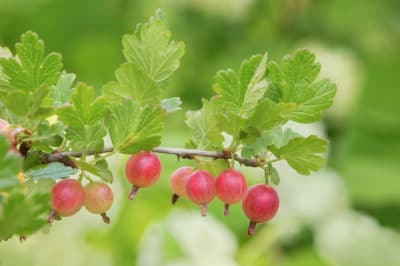American gooseberry powdery mildew
For gooseberry bushes, sunny, warm summer weather is always accompanied by a threat of American gooseberry mildew. This is the widespread fungal infection Sphaerotheca mors-uvae. The leaves, berries, and shoot tips show a mealy-white coating, which gradually turns brown. The gooseberries rot and the leaves dry. How to stop the disease:
-
- cut off all affected shoots
- additionally, shorten all shoot tips by 2 inches
- do not dispose of cuttings in compost under any circumstances
-
- fill a syringe with a solution of 1 tablespoon baking soda, 15 ml soap, and vegetable oil mixed with 2 liters of water
The planting of more resistant gooseberry varieties, such as ‘Rolanda’, ‘Pax’, ‘Reveda’ or ‘Rokula’, has a preventive effect. In addition, consistent pruning after each harvest is highly recommended. All shoot tips should be cut about 2 inches because the fungus spores overwinter here.
Sheet fall disease
Rainy weather minimizes the threat of American gooseberry powdery mildew but opens the door to leaf fall disease. Brown spots can be seen on the foliage, the edges of the leaves turn yellow, and the entire leaf coat falls off. Since no effective remedies are available for the hobby gardener, only effective prevention fends off the disease:
-
- always plant gooseberries at a sufficient distance from each other
- do not grow in dry, sandy, lean soil
- repeatedly spray during the Spring with a mixture of horsetail broth and diluted nettle manure
- change to onion peel with beginning fruit curtain (I don’t understand what this means)
- do not leave leaves under the berry bushes
- thin out regularly and cut back after harvesting
- abundantly water early in the morning
The selection of resistant varieties has also proved its worth here in order to give fungal infections no chance. The main candidates are ‘Rolanda’, ‘Risulfa’ or ‘Rixanta’. The dark red ‘rocula’, however, has proved to be a little prone.
Tips & Tricks
Various pests have specialized in gooseberries. They are called the gooseberry fly, gooseberry tensioner, or gooseberry leaf wasp. In the near-natural garden, there are many beneficial insects. However, birds, hedgehogs, ichneumon wasps, and other pests have a negative effect. A close-meshed insect net protects every berry bush from unwanted visitors.
GTH
